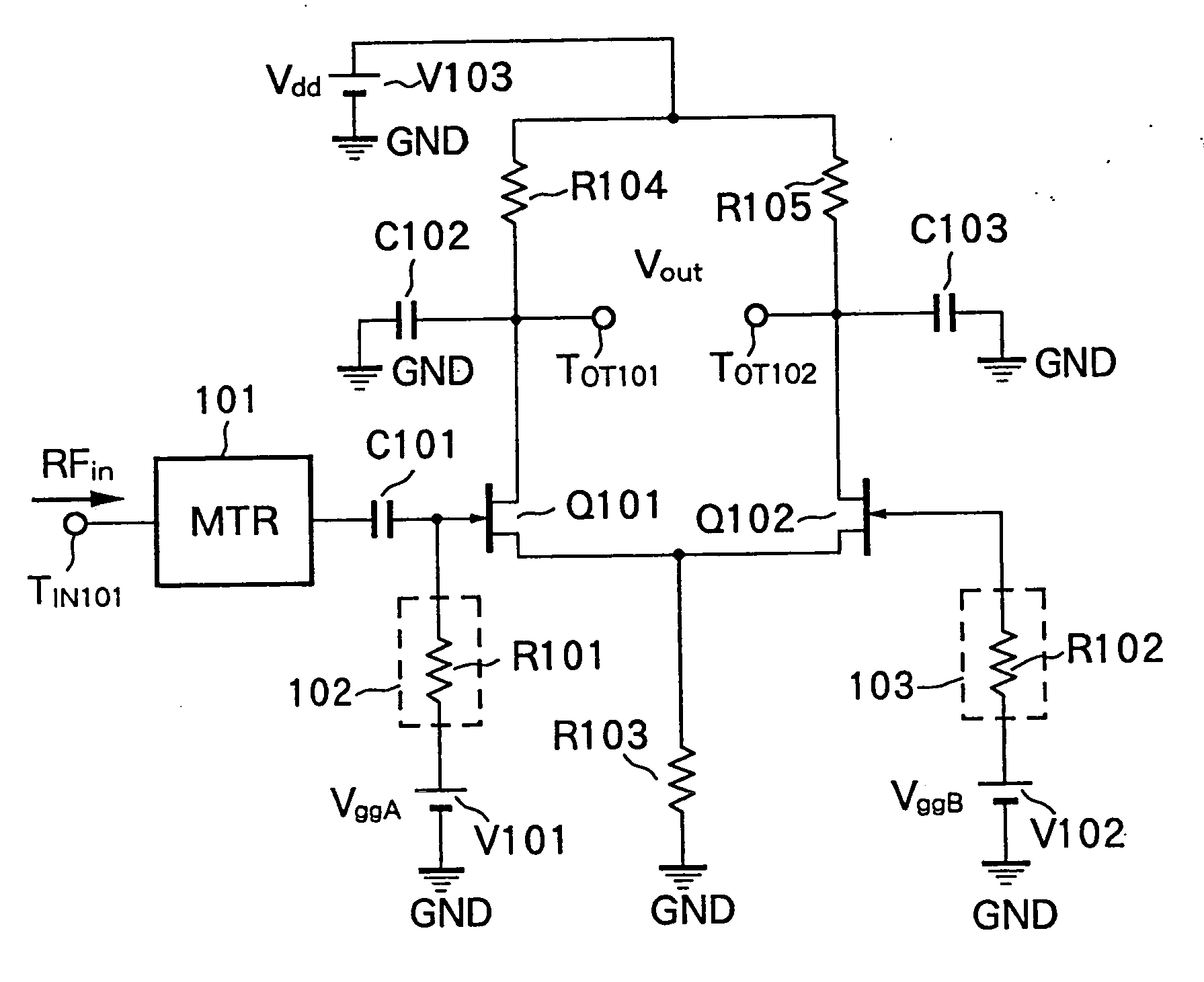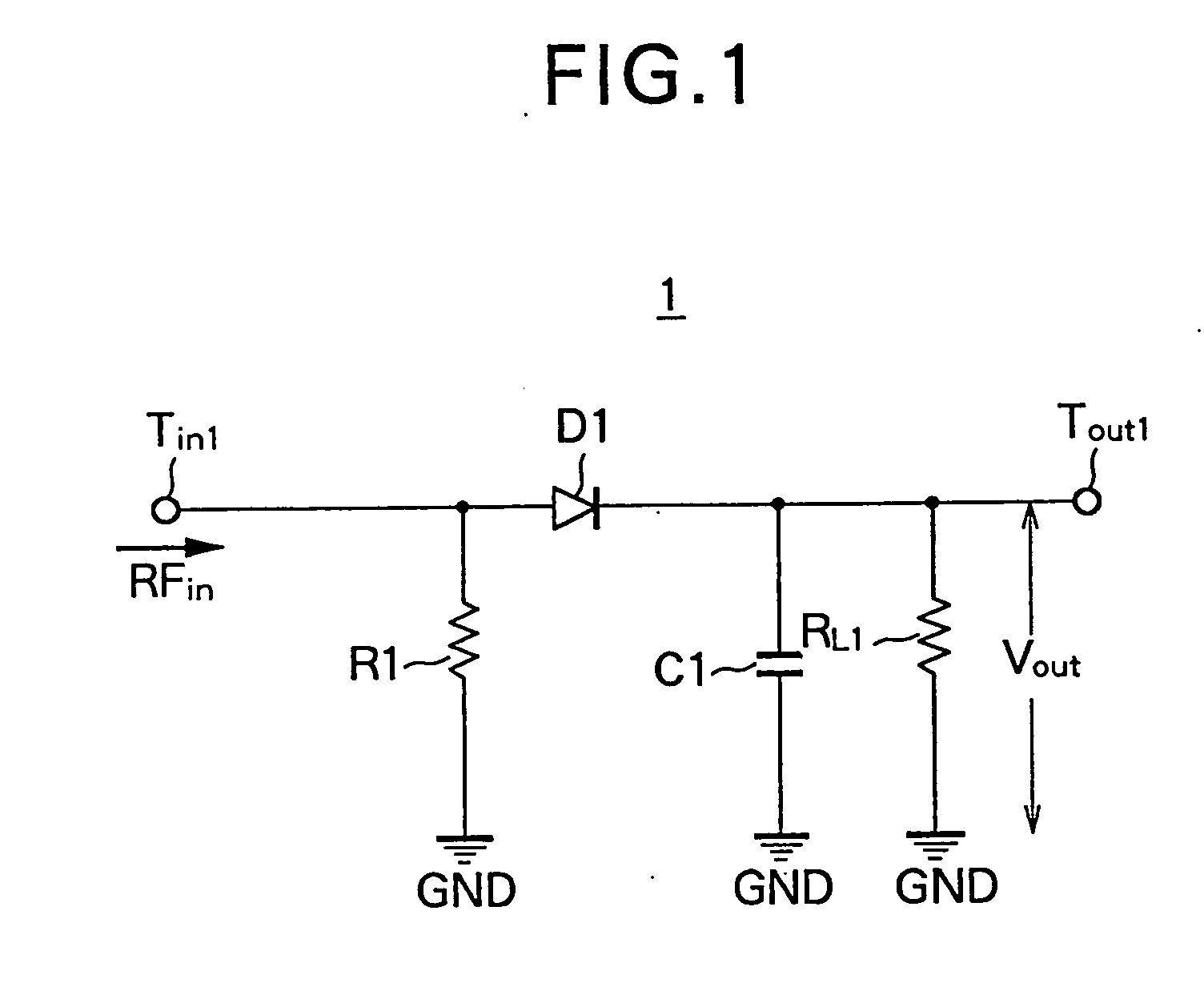Power detecting circuit and demodulator comprising it
a power detection circuit and demodulator technology, applied in the direction of pulse technique, frequency measurement arrangement, instruments, etc., can solve the problems of increasing production costs, conventional power detection circuits using schottky barrier diodes, and inconvenient integration of circuits, etc., to achieve excellent linearity of detection characteristics, low cost, and small variation of detection characteristics
- Summary
- Abstract
- Description
- Claims
- Application Information
AI Technical Summary
Benefits of technology
Problems solved by technology
Method used
Image
Examples
first embodiment
[0080]FIG. 7 is a circuit diagram showing a radio-frequency power detection circuit according to the present invention.
[0081] A radio-frequency power detection circuit 100 according to the first embodiment comprises first and second field-effect transistors (hereinafter, referred to as a transistor) Q101 and Q102 as two active elements, capacitors C101, C102, C103 and C104, resistor elements R101, R102, R103 R104 and R105, voltage sources V101, V102 and V103, and a matching circuit (MTR) 101.
[0082] A gate of the transistor Q101 is connected to one electrode of a DC cut capacitor C101, and the other electrode of the capacitor C101 is connected to an input terminal TIN101 for a radio-frequency signal RFin via the matching circuit 101.
[0083] Also, a gate of the transistor Q101 is connected to an end of the resistor element R101, and the other end of the resistor element R101 is connected to the voltage source V101 having a voltage of VggA. The resistor element R101 configures a first...
second embodiment
[0112]FIG. 10 is a circuit diagram showing a radio-frequency power detection circuit according to the present invention.
[0113] A different point in the second embodiment from the first embodiment explained above is that instead of connecting a resistor element as a current source between the connection point of sources of the transistors Q101 and Q102 and the ground potential GND, a transistor Q103 as a third FET having a gate supplied with a bias voltage from the third gate bias supply circuit 104, is connected.
[0114] The gate bias supply circuit 104 is configured by a resistor element R106 connected between a gate of the transistor Q104 and the voltage source V104 having a voltage of VggC.
[0115] The other configuration in the second embodiment is the same as that in the first embodiment.
[0116] According to the second embodiment, the same effects as in the first embodiment can be obtained.
third embodiment
[0117]FIG. 11 is a circuit diagram showing a radio-frequency power detection circuit according to the present invention.
[0118] The different points in the third embodiment to the first embodiment explained above are that instead of connecting the capacitors C102 and C103 between drains of the transistors Q101 and Q102 and the ground, a capacitor C105 (second capacitor) wherein the capacitance value is set to be a sufficiently large value so that the impedance becomes almost 0 ohm (Ω) in higher frequencies including an input radio-frequency signal Rfin is connected between a drain of the transistor Q101 and the drain of the transistor Q102.
[0119] The other configuration in the third embodiment is the same as that in the first embodiment.
[0120] According to the third embodiment, the same effects as in the first embodiment explained above are obtained, moreover, there are advantages that the number of parts can be reduced, and the fluctuation (variation) of drain potentials of the tr...
PUM
 Login to View More
Login to View More Abstract
Description
Claims
Application Information
 Login to View More
Login to View More - R&D
- Intellectual Property
- Life Sciences
- Materials
- Tech Scout
- Unparalleled Data Quality
- Higher Quality Content
- 60% Fewer Hallucinations
Browse by: Latest US Patents, China's latest patents, Technical Efficacy Thesaurus, Application Domain, Technology Topic, Popular Technical Reports.
© 2025 PatSnap. All rights reserved.Legal|Privacy policy|Modern Slavery Act Transparency Statement|Sitemap|About US| Contact US: help@patsnap.com



